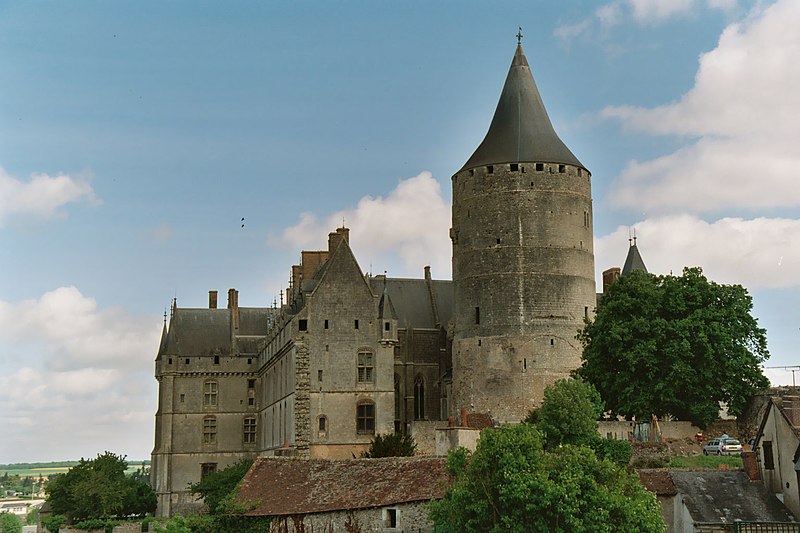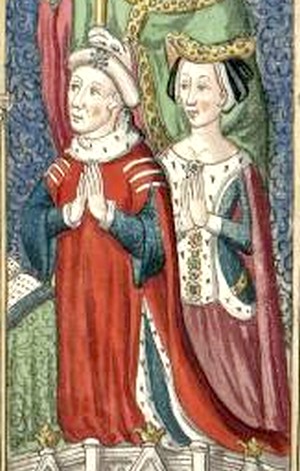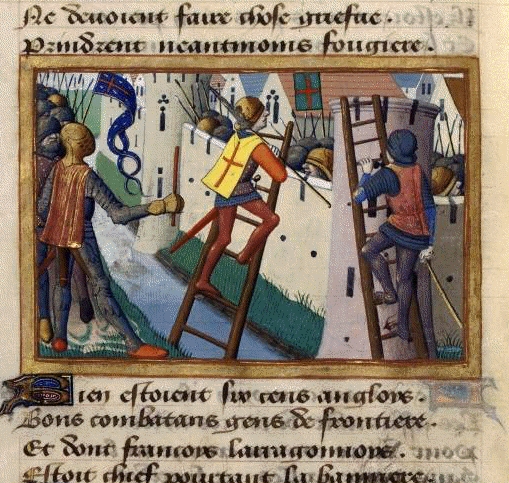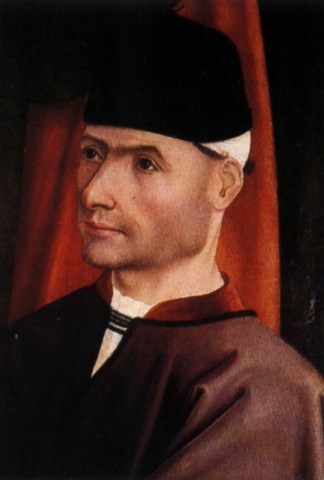 |
| Dunois |
Fall of Rouen
By 18th
October 1449 the French were ready to start the attack on Rouen[i], defended by the Duke of
Somerset. Charles VII was attached to Dunois’ army that had invaded Normandy
from the east. Charles directed the attack on Rouen from Pont-de-l’Arche. Dunois endeavoured to scale the walls
but the stratagem was foiled by Talbot who personally led the counter-attack
which drove the French off.
The citizens
of Caen were divided in their allegiance; one group sent an embassy to London
begging for more troops while back at home a mob demanded of Somerset to
surrender the city. Somerset weakly agreed to allow the Archbishop of Rouen to
negotiate with the French.
The English
retreated to the castle, leaving the town to the French
sympathisers. The castle did not resist the French artillery attacks for long
and within ten days Somerset had agreed to meet Charles’ demands, which
included handing over of eight hostages and among their number was Talbot[ii]. Somerset then scuttled
off to Caen.
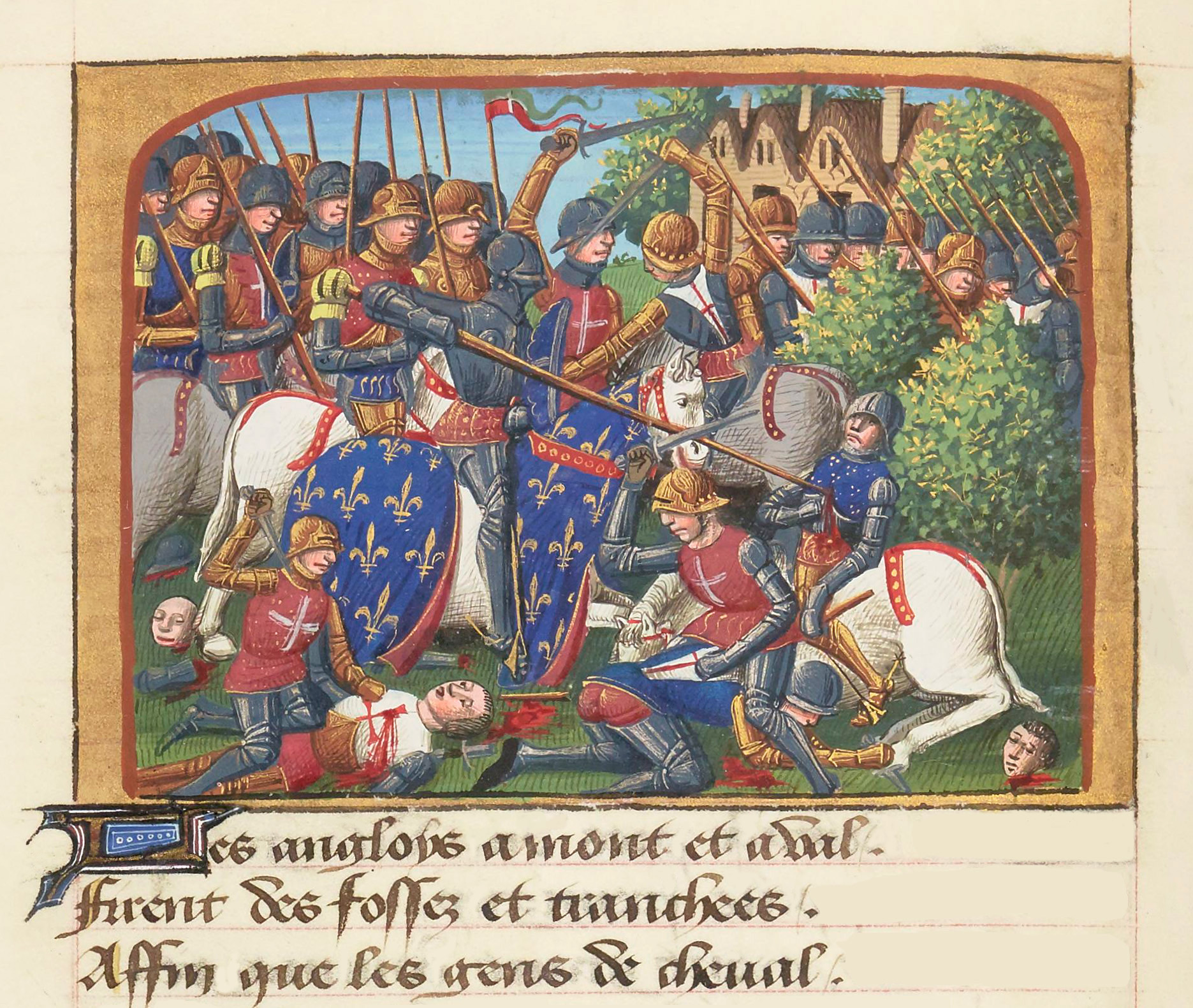 |
| Charles VII enters Rouen |
On 10th
November;
‘The king of France
rode…into his said city, at the side of the Carthusians….Afterwards came the
said lord of Dunois, the lieutenant-general, mounted upon a great horse,
entirely covered with red velvet, with a great White Cross, clothed with a
jacket likewise furred with sable martens….a sword at his side garnished with
gold and precious stones, valued at 20,000 crowns[iii].’[iv]
The
French then turned their attention to the remaining fortresses and towns still
held by the English.
Post Rouen
 |
| Caen |
The
keys of Harfleur were handed over to Dunois on a freezing morning on 1st
January 1450 after a hard siege[v]. All
English resources were being concentrated on Caen, and the armoury of the Tower of London had been emptied to arm the defence of English
France.
1450 was to be a good year
for the French; Honfleur fell on 18th February 1450 and on 15th
April the French nerved themselves up to fight a major battle at Formigny, which about the destruction of the last major
English army in France. Attention was now turned to Caen, which surrendered
after a siege of only seventeen days[vi].
Four
columns were sent against the town which was surrounded. The artillery then
aimed at the fortress. The Duke of Somerset had his family with him and it was
after a cannonball penetrated the ducal nursery where the duchess was with her
children, that the English came to terms. Somerset was granted free passage to
England; he preferred to travel to Calais.
The Castle of Falaise fell to the French on 25th July
and the chateau de Domfront followed suit on 2nd August. Cherbourg fell to the French guns
and surrendered on 11th August 1450. English rule in northern France
was over, bar the enclave at Calais.
 |
| Battle of Castillon |
Now the
French turned their attention southwards. With John of Angoulême at his side,
Jean led the main operation in the initial campaign for the re-conquest of Guyenne. On 30th June 1451 the French entered Bordeaux, but the citizens did not view
themselves as French and in March 1452 sent a deputation to London asking for
help to throw out the usurpers. Henry VI sent the aging Talbot back to France
in October and Bordeaux ejected the French garrison.
On 17th
July 1453 Dunois fought
in the final battle of the war at Castillon. During the battle the hidden gun
emplacements in the French camp resulted in numerous English deaths, including
that of Talbot and his son. One French chronicler recorded;
‘Such was the end of this
famous and renowned English leader who for so long had been one of the most
formidable thorns in the side of the French, who regarded him with terror and
dismay.’[vii]
Bayonne fell on August 18th
1453 and on 3rd October 1453 Charles signed the treaty for
return of Aquitaine[viii] to the French town. With the loss of Talbot the English
in Bordeaux lost heart and on 10th October the French took back
their prize.
Civilian Pursuits
Dunois and
Marie had two children;
Dunois also had a bastard named Jean d'Orléans by his mistress
Isabelle de Dreux. Jean was now a rich man, whose
exploits as well as his birth, albeit on the wrong side of the blanket, had
made him a man of standing and renown. At some time between 1440 and 1450
Dunois had a Book of Hours made for himself by the illustrator known as the Dunois Master[xi]. The book was made in Paris at some
time after Dunois helped relieve the city. |
| Dunois (R) at table |
Dunois was a
key witness in the Retrial of Joan of Arc ordered by Charles VII to
rehabilitate the Maid and for his own propaganda exercise. His detailed evidence
was taken down and placed before the prelates considering the matter at the
tribunal. On 7th July 1456 Joan was declared innocent of heresy;
‘We, in session of our court and having God only before our eyes….proclaim
that Joan did not contract any taint of infamy and that she shall be and is
washed clean of such.’[xii]
Between 1459
and 1468 Dunois added the west wing, the ‘aile Dunois’, to his chateau at Chàteaudun, given
him by his brother Orléans.
Insurrection
.jpg) |
| Duc de Berri |
With the death of Charles VII in July 1461 Dunois saw
his former comrade in arms Louis become king. Four years later, in 1465, the Duc de Berri and the Duke of Brittany rose up against Louis XI; they led
the League of the Public Weal; Dunois was another of the league’s leaders. He and his
half-brother Charles were angered by Louis’ alliance with Francesco Sforza, who had taken the Duchy of Milan that the Orléans
family believed was theirs’ through Valentina Visconti.
Louis’ tongue was responsible for much of the
dissatisfaction among his nobles, that and his determination to control them
more closely. His treatment of the Orléans family was a case in point; Louis
had publicly mocked the family’s Italian ambitions[xiii] and referred
slightingly to Dunois as ‘an elder of
Susannah’ and had made fun of Charles’ wife’s pregnancy
The rebellion was joined by the Duke of Burgundy, who
was persuaded to support the league by
his son the Count of Charolais, following an attempt on his life believed
to have been orchestrated by Louis,
 |
| Count of Charolais |
‘My lord of Berry….is indeed
near Chartres with [my] fair cousins of Brittany and Dunois and a large army
and that the king has left Bourbonnais to withdraw up here.’[xiv]
In March
Dunois loaded his valuables onto a barge and floated them down the Loire to
become the revolt’s leading light. Louis assembled an army as Bourbon’s men
took over key positions in the Bourbonnais and the Auvergne. Along with Odet d’Aydie[xv] Dunois was entrusted with
countering the king’s propaganda which he did with great enthusiasm, making
claims on Bourbon’s behalf of ill-treatment by Louis.
By July the
king was at Beaugency awaiting the arrival of the rebel army, led by Dunois who
was suffering from gout but directing operations from a litter. The rebels took
up position in Dunois’ fortress at Chateaudûn, in a position to fall on the
king’s flank or to join with the Burgundian army.
After a
series of stalemates the league presented its demands to a delegation from the
king and Dunois was the one chosen to make the presentation. Louis made peace
with the princes at the Treaty of St Maur on 25th October 1465. He
made concessions to the various nobles ranged against him and, having pardoned
him, Louis placed Dunois at the head of the Council of Thirty Six, a committee
to review abuses of government. But like his father before him Louis was not
one to be bound by treaties he made.
Dunois’ wife
Marie died in 1464 and Dunois died on 23rd November 1468 at the
château de L'Haÿ-les-Roses. At some time before his death Dunois
was made Governor of St Germain-en-Laye.
He was buried in the basilica of Notre Dame de Cléry where later Louis XI was also interred, leaving behind him
a reputation as one of France’s greatest captains.
Bibliography
The Hundred
Years War – Alfred Burne, Folio Society 2005
The Reign of
Henry VI – RA Griffiths, Sutton Publishing Ltd 1998
The
Fifteenth Century – EF Jacob, Oxford University Press 1997
Louis XII –
Paul Murray Kendall, Sphere Books Ltd 1974
John Talbot
and the War in France – AJ Pollard, Pen and Sword Military 2005
Philip the
Good – Richard Vaughan, Boydell Press 2014
www.wikipedia.en
[i]
The capital of English Normandy
[ii]
Who was not released until July 1450 when men under his command surrendered
Falaise
[iii]
In 2015
the relative: historic standard of living value of that income or wealth is £14,360.00 labour earnings of that income or wealth is £117,200.00. economic status value of that income or wealth is £478,900.00 economic power value of that income or wealth is £8,993,000.00 www.measuringworth.com
[iv]
Henry VI - Griffiths
[v]
Somerset had promised to hand the port over
[vi]
Despite a reputation as the strongest castle in Normandy
[vii]
Hundred Years War - Burne
[viii]
Nearly 300 years after Eleanor of Aquitaine
brought the county as her dowry when marrying Henry II in 1152
[ix]
Later Count of Dunois, Tancarville,
Longueville, and Montgomery, Baron of Varenguebec, Viscount of Melun, Chamberlain of France,
Governor of Normandy and the Dauphiné, Constable and Chamberlain of Normandy, married 2 July 1466 to Agnès de Savoie (1445–1508).
They had one son, François
d'Orléans-Longueville (1447-1491), who eventually became the duc de
Dunois-Longueville
[x]
Married 14 May 1468 to Johann II of Nassau-Saarbrücken (1430–1472), Count of Roucy; died in 1501
[xiii]
Which Charles son Louis
was to pursue when he became king after the death of Louis’ son Charles VIII;
see http://wolfgang20.blogspot.co.uk/2015/10/renaissance-france-anne-of-brittany-v.html
[xiv]
Philip the Good - Vaughan

